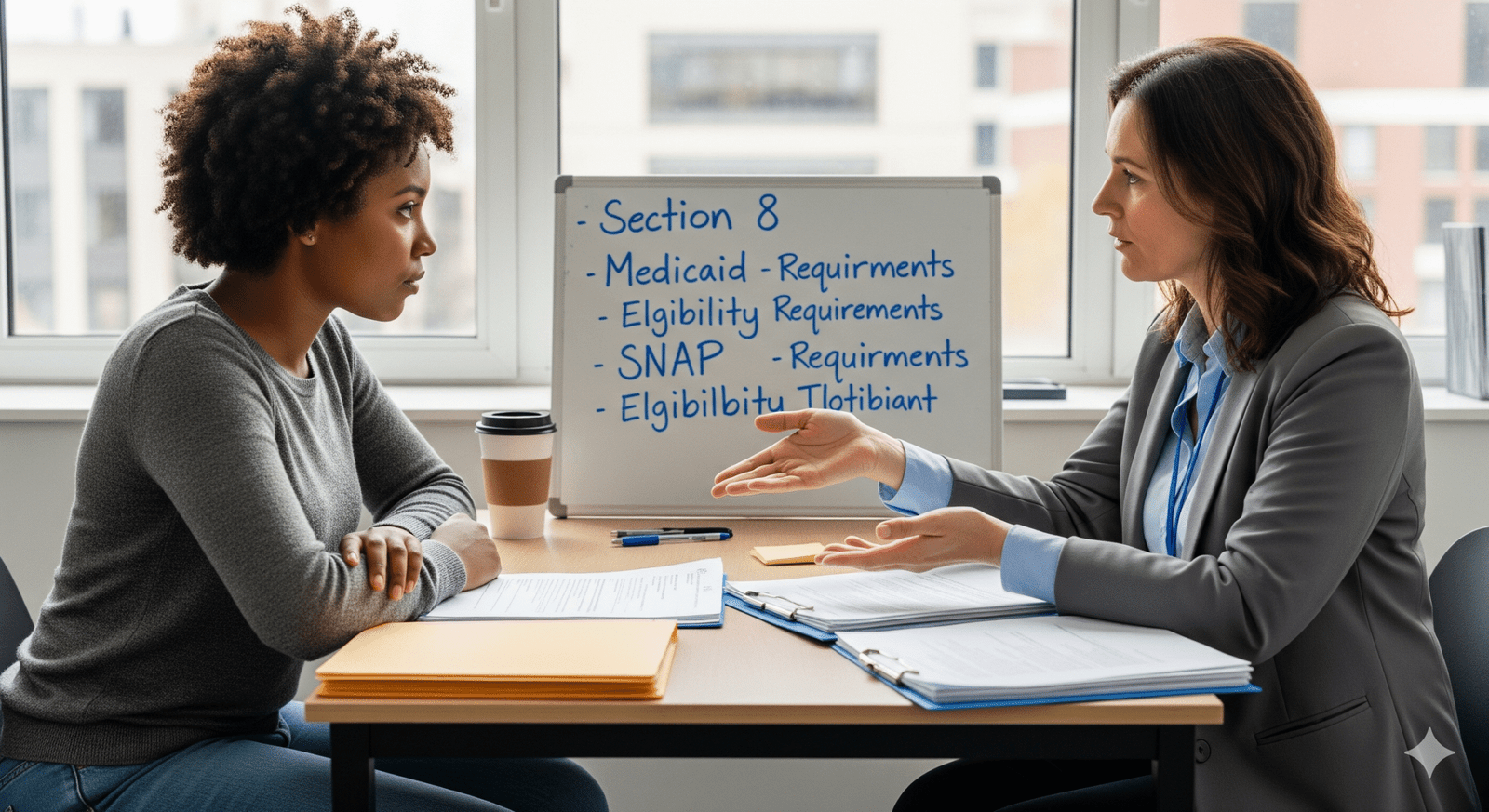Accessing multiple public benefit programs like Section 8 housing vouchers, Medicaid, and SNAP can feel overwhelming, especially when bureaucratic silos make coordination difficult. Yet, bringing these programs into alignment can reduce administrative hurdles, prevent benefits “churn,” and improve the stability and well-being of low-income families—particularly seniors, veterans, and those on fixed incomes. This guide walks you through the key strategies, successful state approaches, and practical tips for coordinating support effectively.
1. Understanding the Programs
Section 8 Housing Vouchers
Administered by HUD and local Public Housing Authorities (PHAs), Section 8 helps low-income individuals, seniors, and people with disabilities cover rent in privately-owned housing. Tenants typically pay 30–40% of their income, and PHAs pay the remainder directly to landlords (Center on Budget and Policy Priorities, Wikipedia).
SNAP (Supplemental Nutrition Assistance Program)
Provides food purchasing assistance to eligible low-income individuals and families.
Medicaid
Health coverage for low-income individuals and families, often overlapping with SNAP and housing assistance.
According to federal data, among those receiving housing assistance, 63% also receive Medicaid and 59% receive SNAP (ASPE).
2. Why Coordination Matters
Reduction in Administrative Burden and Churn
When agencies share data and eligibility findings, it enables faster and more seamless enrollment. For instance, Louisiana used SNAP data to fast-track Medicaid enrollment—saving over $1.5 million in administrative costs and tens of thousands of labor hours (Medicaid Food Security Network).
Improved Health and Economic Outcomes
Multiple studies show that participation in complementary programs (e.g., SNAP + Medicaid) improves health, reduces healthcare spending, and boosts financial stability (PMC).
3. State-Level Strategies and Best Practices
Shared Data Systems
Though full system integration is rare, most states share key data—such as SNAP status, demographics, income, and household make-up—across agencies. Only 4 out of 47 reported not sharing anything (Medicaid Food Security Network).
Express Lane Eligibility (ELE) & Fast Track SPA
- ELE: Allows children enrolled in SNAP or TANF to be renewed for Medicaid without reapplication.
- Fast Track SPA: Automates Medicaid enrollment and renewal for non-disabled, non-elderly SNAP recipients (Medicaid Food Security Network).
Several states also use unwinding waivers tied to PHE (public health emergency) unwind to expedite Medicaid renewals using SNAP data (Medicaid Food Security Network).
Third-Party Coordination
States often share data with MCOs (Managed Care Organizations) and nonprofits, supporting screening (e.g., for food insecurity) and targeted outreach. More than 30 states involve MCOs; 21 involve nonprofits (Medicaid Food Security Network).
Other Program Linkages
Beyond SNAP and Medicaid, many states share benefits data with programs like TANF, WIC, school meals, LIHEAP, and more (Medicaid Food Security Network).
4. Challenges in Coordination
- Technology and Funding Gaps: Outdated systems and limited resources block integration (PMC).
- Policy Misalignment: Differing eligibility rules across programs hinder seamless coordination.
- Siloed Agencies: Lack of unified vision and finger-pointing between agencies slow progress (PMC).
- Worker Training Gaps: Caseworkers may not be well-informed across programs, leading to missed co-enrollment opportunities (PMC).
5. Strategies to Improve Coordination
Data Sharing and MOUs
Implement Memorandums of Understanding between agencies to share data securely and streamline eligibility across programs.
Leverage ELE & Express Lane
Use federal options like ELE and Fast Track SPA to reduce reapplication burdens and deepen cross-program linkage.
One-Stop Caseworker Training
Train caseworkers to understand SNAP/Medicaid eligibility while helping applicants access Section 8—facilitating “warm handoffs” between agencies (Medicaid Food Security Network, PMC).
Partner with MCOs and Nonprofits
Engage third-party organizations to conduct outreach and enroll eligible individuals across multiple programs simultaneously.
Policy Innovation
Advocate for federal and state policy adjustments that align eligibility criteria and funding support for integrated systems.
6. Tangible State Examples
- Louisiana used SNAP data to auto-enroll individuals into Medicaid, saving significant money and labor (Medicaid Food Security Network, PMC).
- South Carolina used SNAP/TANF data to automatically renew Medicaid for children through ELE, renewing 65,000 children efficiently (Medicaid Food Security Network).
- BDT’s outreach in Pennsylvania led to an 11% increase in SNAP applications and a 7% increase in approvals within 90 days (Medicaid Food Security Network).
7. FAQ Section
Q1: Does receiving a Section 8 voucher impact SNAP eligibility?
Typically, no. A housing subsidy like Section 8 is considered “in-kind” and not counted as income for SNAP. However, SNAP may only count the portion of rent you pay yourself toward your housing deduction.
As one user explained on Reddit:
“A housing subsidy is… not considered income for SNAP.” (Reddit)
Q2: Can SNAP status be used to simplify Medicaid enrollment?
Yes. Many states leverage SNAP data through Express Lane Eligibility or Fast Track programs to streamline Medicaid enrollment and renewal.
Q3: What percentage of people on Section 8 also receive SNAP or Medicaid?
About 63% of Section 8 recipients also receive Medicaid, and 59% receive SNAP (Medicaid Food Security Network, ASPE).
Q4: What are the main hurdles to coordinating these programs?
Key challenges include outdated tech systems, lack of interagency collaboration, policy misalignment, inadequate training for caseworkers, and insufficient funding (PMC).
Coordinating Section 8, SNAP, and Medicaid isn’t just efficient—it’s transformative. Families gain stability in housing, food, and healthcare when agencies work together through data sharing, federal options like ELE, caseworker coordination, and third-party partnerships. As agencies modernise and integrate, they build stronger, more human-centred safety nets—especially vital for seniors, veterans, and those on fixed incomes.

